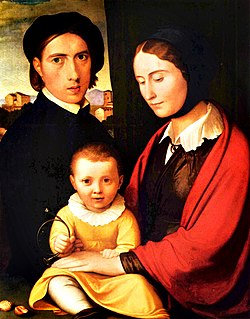Johann Friedrich Overbeck
| Johann Friedrich Overbeck | |
|---|---|

Self-portrait with family, c. 1820, Behnhaus.
|
|
| Born |
3 July 1789 Lübeck, Germany |
| Died | 12 November 1869 (aged 80) Rome, Italy |
| Nationality | German and naturalized Italian |
| Education | Heinrich Füger in Vienna |
| Known for | Painting |
| Movement | Neoclassicism |
Johann Friedrich Overbeck (3 July 1789 – 12 November 1869) was a German painter and member of the Nazarene movement. He also made four etchings.
Born in Lübeck, his ancestors for three generations had been Protestant pastors; his father Christian Adolph Overbeck (1755–1821) was doctor of law, poet, mystic pietist and burgomaster of Lübeck. Within a stone's throw of the family mansion in the Konigstrasse stood the Gymnasium, where the uncle, doctor of theology and a voluminous writer, was the master; there the nephew became a classic scholar and received instruction in art.
The young artist left Lübeck in March 1806, and entered as student the academy of Vienna, then under the direction of Heinrich Füger. While Overbeck clearly accrued some of the polished technical aspects of the neoclassic painters, he was alienated by lack of religious spirituality in the themes chosen by his masters. Overbeck wrote to a friend that he had fallen among a vulgar set, that every noble thought was suppressed within the academy and that losing all faith in humanity, he had turned inward to his faith for inspiration.
In Overbeck's view, the nature of earlier European art had been corrupted throughout contemporary Europe, starting centuries before the French Revolution, and the process of discarding its Christian orientation was proceeding further now. He sought to express Christian art before the corrupting influence of the late Renaissance, casting aside his contemporary influences, and taking as a guide early Italian Renaissance painters, up to and including Raphael. After four years, their differences between his group and others in the academy had grown so irreconcilable, that Overbeck and his followers were expelled.
He left for Rome, where he arrived in 1810, carrying his half-finished canvas of Christ's Entry into Jerusalem. Rome became for 59 years the centre of his labor. He was joined by a company of like-minded artists, including Peter von Cornelius, Friedrich Wilhelm Schadow and Philipp Veit, who jointly housed in the old Franciscan convent of San Isidoro, and became known among friends and enemies by the descriptive epithet of Nazarenes. Their precept was hard and honest work and holy living; they eschewed the antique as pagan, the Renaissance as false, and built up a severe revival on simple nature and on the serious art of Perugino, Pinturicchio, Francesco Francia and the young Raphael. The characteristics of the style thus educed were nobility of idea, precision and even hardness of outline, scholastic composition, with the addition of light, shade and colour, not for allurement, but chiefly for perspicuity and completion of motive. Overbeck in 1813 joined the Roman Catholic Church, and thereby he believed that his art received Christian baptism.
...
Wikipedia
